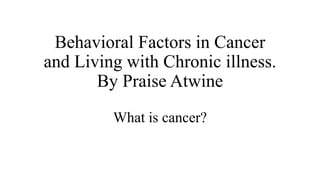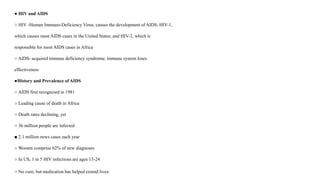Cancer and Living with Chronic Illness ppt.pptx
- 1. Behavioral Factors in Cancer and Living with Chronic illness. By Praise Atwine What is cancer?
- 2. Cancer -group of diseases characterized by the presence of new cells that grow and spread beyond control They’re different types of cancers: all commonly share the presence of *Neoplastic tissue cells which may be benign or malignant *Benign - remain localized; usually less threatening *Malignant - spread; usually more dangerous because they can invade and destroy surrounding tissue
- 3. Four main groups of malignant growths: Carcinomas - cancers of the epithelial tissue, cells that line the outer and inner surfaces of the body, such as skin, stomach lining, and mucous membranes. Sarcomas - cancers of the connective tissues (bone, muscles, cartilage) Leukemias - cancer of the blood Lymphoma - cancers of the lymphatic system; less common
- 4. Rates of cancer Death rates for cancer declined during the 1990s * Early detection and treatment * Lifestyle factors (better diets, less smoking) play a large role in the lower rates of cancer Cancers with decreasing death rates *Lung, breast, prostate, colon/rectum cancer rates have all declined Rates of cancer; increasing death rates Cancers with increasing death rates *Liver cancer *Melanoma (a form of skin cancer) *Esophageal cancer (increased for men, decreased for women) *Lung cancer (increase for women, decrease for men)
- 5. Cancer risk factors Inherent Risk Factors *Ethnic Background African Americans have greater incidence for most cancer and greater mortality as well *Diagnoses for African Americans tend to come at a later stage, which means lower survival rates *Other ethnic minorities do not show this increased incidence even though they do also tend to be diagnosed at latter stages of their cancer too Environmental; *Exposure to asbestos *Exposure to radiation
- 6. Cancer risk factors: Genetics Inherent Risk Factors for Cancer *Advancing age Inherent Risk Factors *Family History and Genetics *Identification of specific genes *Example: BRCA 1 and BRCA 2 for breast cancer *Only 5-10% of cancers are due to specific inherited genes
- 7. Cancer risk factors: Smoking Behavioral Risk Factors for Cancer Smoking - mainly related to lung cancer but also can be the cause of stomach, bladder, upper digestive tract, esophagus, colon, and prostate cancers *Also increases risk for larynx, pharynx, oral cavity, sinuses, cervix, pancreas, liver, and kidney cancers *Those who smoke are 24.9 times more likely to die of lung cancer than men who have never smoked (relative risk) *Smokers may have optimistic bias, where they realize that smoking is a health risk but believe they personally are not at risk.
- 8. Cancer risk factors: Diet Behavioral Risk Factors for Cancer: Diet *Foods that may cause cancer are called carcinogenic *Foods that lack preservatives or foods that have certain preservatives *Foods high in fat *Consumption of preserved meat raises the risk for colorectal cancer • Obesity accounts for 14-20% of all cancer-related deaths; related to esophagus, breast, endometrial, and kidney cancers.
- 9. Behavioral Risk Factors for Cancer: Diet *Foods that may prevent cancer *Fruits and veggies *Unclear if certain nutrients or specific vitamins can help *Beta-carotene, selenium, and calcium may help lower risk of certain cancers Cancer risk factors: lifestyle Behavioral Risk Factors for Cancer *Alcohol increases risk for mouth, esophageal, breast, and liver cancers Alcohol abusers are more likely to die from other causes before they develop liver cancer.
- 10. Living with Chronic Illness • This chapter focuses on six basic questions: 1. What is the impact of chronic disease on patients and families? 2. What is the impact of Alzheimer’s disease? 3. What is involved in adjusting to diabetes? 4. How does asthma affect the lives of people with this disease? 5. How can HIV infection be managed? 6. What adaptations do people make to dying and grieving?
- 11. ● Chronic Diseases ○ Include Cardiovascular disease and cancer, Alzheimer’s disease, diabetes, asthma, and AIDS ○ Causes 7 in 10 deaths in the USA ○ 60% of adults live with a chronic illness, 42% live with multiple illnesses and 25% of children ○ Chronic illnesses vary in physiology, but the emotional and physical adjustments, the disruption of family dynamics, the need for continued medical care, and the necessity of self-management also apply to any other chronic diseases such as arthritis, heart disease, cancer, kidney disease, multiple sclerosis, head injury, and spinal cord injury.
- 12. ● Impact on the Patient ○ Patients with chronic illness need to: ■ Adjust and adapt to symptoms ■ Manage stress of treatment ■ Face the possibility of death ■ Some people find positive aspects of their chronic illness ■ Some effective mental health treatments such as psychosocial, cognitive behavioral, and internet-based interventions
- 13. ●Impact on the Family ○ Illness requires adaptation from family members as well ■ Feelings of grief or loss ■ Parents of children with chronic illness may face difficulties, such as maintaining a normal routine ■ “Invisible Support” - provider reports offering but patient does not report receiving; less effective and helpful. In Summary; Chronic diseases bring changes that require adaptation for both the person with the disease and family members. Chronically ill patients must manage their symptoms, seek appropriate health care, and adapt to the psychological changes that occur in this situation. Health care professionals may neglect the social and emotional needs of chronically ill patients, attending instead to their physical needs. Health psychologists and support groups help provide for the emotional needs associated with chronic illness. The adaptations that occur may lead to prolonged feelings of loss and grief or to changes that constitute personal growth.
- 14. ● Alzheimer’s Disease ○ Alzheimer’s Disease degenerative disease of the brain ■ Early-onset: Occurs before 60; rare; genetic component ■ Late-onset: Occurs after 60; more common; may have genetic component but lifestyle factors may also play a role ●Alzheimer’s Disease, Risk Factors ■ Age - by age 85, 50% of individuals show signs ■ Genetic factors - genetic component related to apolipo-protein ε, a protein involved in cholesterol metabolism
- 15. ■ Environmental factors - stroke, head injury, Type 2 diabetes, and CVD all increase risk ■ Lifestyle factors - exercising, cognitive activity, low level of alcohol consumption decrease risk ● Symptoms of Alzheimer’s Disease ○ Memory loss ○ Paranoia/Suspicion ○ Verbal and Physical Aggression ● Alzheimer’s Disease and Depression ○ Depression is often common ○ Individuals in the early stages may be aware enough to realize what is occurring ● Alzheimer’s Disease, Coping
- 16. ● Alzheimer’s Disease, Coping ○ Helping people with Alzheimer’s Disease ○ No cure ○ Currently, the primary treatment is drugs to slow down progression of memory loss and retain cognitive abilities ○ Other approaches include cognitive stimulation, improvements in communication ●Alzheimer’s Disease, Helping Family Members Cope ○ Helping family members: ■ 70% of caregivers are women ■ Caregiving is full-time usually (10+ hours a day) ■ Caregivers experience poor physical and psychological health ■ Caregivers can seek support groups in person or over the internet
- 17. ●Diabetes ○ Diabetes mellitus- disorder caused by insulin deficiency ■Insulin dependent (Type 1) -autoimmune disorder; occurs usually before age of 30; cannot produce insulin; no cure; the person’s immune system attacks the insulin-making cells in the pancreas, destroying them ■ Non-insulin dependent (Type 2)- more common, The body still produces insulin, but it’s unable to use it effectively. Inactive and overweight ● Impacts of Diabetes ○ Physical Changes ■ diabetes increases risk of CVD, damage to retina, kidney diseases, and pancreatic cancer ○ Behavioral/Lifestyle Changes: ■ Diabetes must test blood sugar levels at least daily ■ May affect sexual functioning
- 18. ●Diabetes, Helping People Cope ○ Research on diabetes ■ Stress affects glucose metabolism ■ Decreasing stress and negative emotions can help diabetes management ○Adherence to regimens ■ Social support groups may help increase diabetes management ■ Text messages reminders ○ Lifestyle changes including healthy eating and exercise ○ New strategies including testing devices for tears and infrared laser lights; still in development
- 19. ●Asthma ○ Asthma -inflammatory disease that causes constriction of the bronchial tubes, preventing air pass freely ■ 7.7% (26 million) of Americans have asthma ■ 30% of cases are children and adolescents ● Risk Factors for Asthma ○ More common in developed countries ○ More common in urban area ○ More common for African Americans ○ Sedentary lifestyle (tending to spend much time seated; somewhat inactive) and obesity increase risk
- 20. Managing Asthma ○ Minimizing attacks is main treatment goal ○ Requires medication and learning “triggers” of attacks ○ Drugs often have side effects of weight gain and lack of energy ○ Asthmatics may rely on inhalers too often ●Asthma, Helping People Cope ○ Increase education ○ Boosting self-care and adherence ○ Developing a written action plan
- 21. ● HIV and AIDS ○ HIV -Human Immuno-Deficiency Virus; causes the development of AIDS; HIV-1, which causes most AIDS cases in the United States; and HIV-2, which is responsible for most AIDS cases in Africa ○ AIDS- acquired immune deficiency syndrome; immune system loses effectiveness ●History and Prevalence of AIDS ○ AIDS first recognized in 1981 ○ Leading cause of death in Africa ○ Death rates declining, yet ○ 36 million people are infected ■ 2.1 million news cases each year ○ Women comprise 62% of new diagnoses ○ In US, 1 in 5 HIV infections are ages 13-24 ○ No cure; but medication has helped extend lives
- 22. ●Symptoms of HIV and AIDS ○ First symptoms: flu-like symptoms (fever, sore throat, skin rash, headache) ○ Immune system is being destroyed, CD4+ count falls ○ As CD4+ count decreases, damage to organs occurs, as well as weight loss, fatigue, and AIDS-related dementia ●Transmission of HIV ○ Person to person during sex ○ Direct contact with blood ■ Injection drug use ○ Mother to child during pregnancy, birth, or breastfeeding ●Transmission of HIV from sexual acts: ○ Male-male sexual contact - anal intercourse; oral sex ○ Heterosexual contact - male to female transmission more likely than female-to-male transmission
- 23. ●Psychologists’ Role in the HIV Epidemic ○ Primary prevention-changing behavior to decrease transmission of HIV ○ Secondary prevention-helping people live with infection ●Preventing HIV/AIDS (Primary) include; ■ Reducing unprotected sexual activities ■ Increasing perception of risk ●Preventing HIV/AIDS (Secondary) include; ■ Encouraging HIV testing ■ Coping with HIV diagnosis ■ Tailoring interventions to person’s specific situation ■ Finding meaning ■ Adhering to complex medical regime ■ Motivational interviewing
- 24. ● Facing Death ○ Adjusting to Terminal Illness ■ People do not respond to a diagnosis in a set pattern ■ "Dying role" ■ 3 elements: practical, relational, personal ■ Dignity Therapy ■ Reflection, recording what they want to be remembered for ● Grieving ○ People grieve generally in one of four ways: ■ Resiliency ■ Acute-recovery ■ Chronic low level of well-being ■ Improvement























